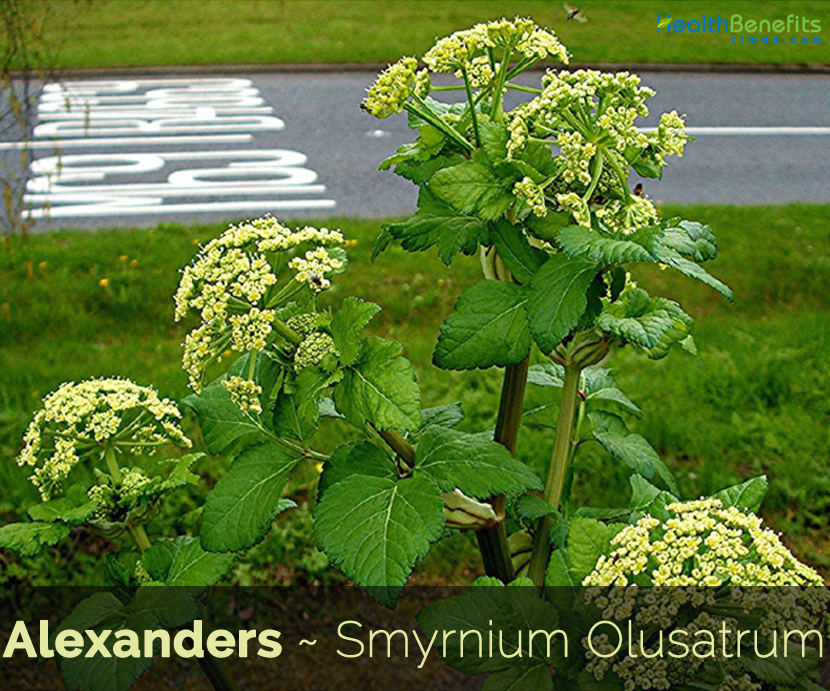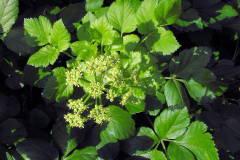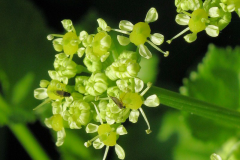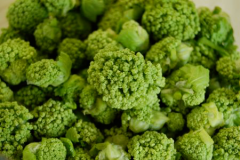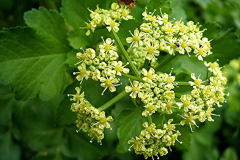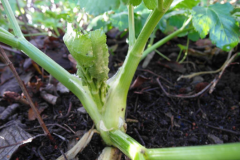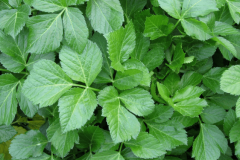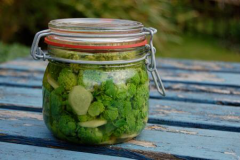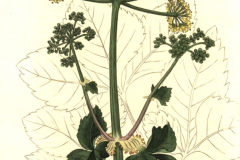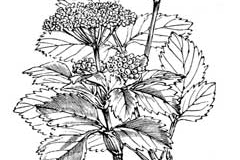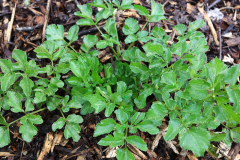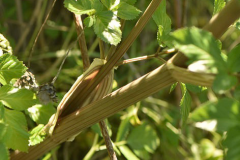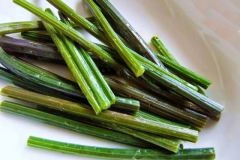The species name olusatrum comes from olus, meaning ‘pot herb’ (cooking vegetable) and atrum meaning ‘black’ in reference to the black seeds. It is also commonly called Black Lovage. Common name Alexanders means ‘of Alexandria’ in the reference to its geographical origin in Alexandria, North Africa though some references speculate that it may have been named after Alexander the Great. Called Hipposelinon by the Greeks, a word which means ‘parsley’ or ‘horse celery’, it was used to distinguish it from cultivated celery (Apium graveolens).
Plant Description
Alexanders is a stout, glabrous, celery‐scented, herbaceous, semelparous, facultative biennial herb that grows up to 150 centimeters (59 in) high. The plant grows abundantly in salt-marshes and uncultivated land near the sea, nominally in lime soils, in hedges, woods, waysides, woodland garden sunny edge, dappled shade, shady edge, hedgerow, coastal areas, roadsides, wastelands, ancient ruins, banks and quarries. The plant has thick elongated tap‐root 50–60 cm and finer lateral roots near surface. Solid stems are up to 150 cm which becomes hollow and grooved with age.
Leaves
This species has opposite shades of glossy green leaves. These are composite, with large and dentulous leaves. Basal leaves are larger and have three separate oval segments, 3-4 cm wide and about 10 cm long. The upper leaves, smaller than the first ones, consist of three leaflets. The petioles, with reddish veins, are enlarged to their base, inguing the stem.
Flower
Alexanders is considered by umbrella inflorescences composed about 6-12 small umbrellas, with long peduncles with many spokes. Flowers of this species are small, with pentametric symmetry with yellow-greenish petals. These have a two-carat egg ovary at the center. Sepals are almost absent or very small and the cup is nearly totally fused to the ovary. Ovary carries two styles that spread to the base in a necroweight disc. Flowers of this plant are hermaphrodites and are frequented and pollinated by insects. Flowering of the plant normally occurs in a period between May to June.
Fruit
The fruit is a 4-5 mm long globular schizocarp, comprising two single‐seeded mericarps, broadly ovoid, laterally compressed. Fruits are initially green turning to blackish color as they mature. Each mericarp have three distinct, sharp ridges and numerous vittae, which exude pungent myrrh‐like oil. Air‐dry mass of dispersules averages 20.5 mg with seeds ranging between 2.5 and 4.0 mg.
History
Known to Theophrastus and Pliny the Elder, its roots are diuretics, its leaves make a healing juice for cuts and its crushed seeds were a popular condiment. Pliny recommended chewing “Alexander’s herb” with aniseed and a little honey in the morning to sweeten the breath. Alexanders was introduced into Britain by the Romans (hence the name “Roman celery”) but fell out of fashion with the introduction of new varieties of celery in the 19th century. John Evelyn, in his 1699 Acetaria: A Discourse of Sallets [Salads] describes Alexanders as a “moderately hot, and of a cleansing faculty,” comparing it favorably to parsley. “Ellicksander Pottage” was described by Robert May in The Accomplish’t Cook (1660): “Chop ellicksanders and oatmeal together, being picked and washed, then set on a pipkin with fair water, and when it boils, put in your herbs, oatmeal, and salt, and boil it on a soft fire, and make it not too thick, being almost boil’d put in some butter.” According to Culpeper it was an herb of Jupiter, and he recommended the aforementioned Alexander pottage. Alexanders was carried on ships as a remedy against scurvy.
Health Benefits of Alexanders
Alexanders were used for culinary purposes. It is used in the place of Parsley while cooking. It is mostly known for its usage in herbal medicine and all the parts of the plant was used for cooking in some way or the other. Listed below are few of the health benefits of using Alexanders
1. Helps to cure scurvy
Scurvy is the disease caused mainly due to insufficiency of Vitamin C. It results in swelling and bleeding of gums and also weakening. Alexanders were used for curing such problems in the teeth when any other herb rich in Vitamin C were not accessible to support.
2. Cure for Dropsy
Alexanders plant was anciently used to cure dropsy. Dropsy is actually a swelling of the tissue layers in the body resulting due to accumulation of water. Person suffering from dropsy in the before years, would use this plant’s oil and extracts in order to get cured of the swelling.
3. Helps in Menstruation
Alexanders herb acts as an Emmenagogue. Emmenagogue is an herb that is consumed for increasing blood flow in pelvic and uterus parts of the body. Any disorder in the menstruation cycle of a woman which is caused not due to pregnancy then they can intake emenagogue to cure it. Seeds of alexanders, when consumed along with wine, act as Emmenagogue and helps in menstruation.
4. Heal for cuts
Alexanders also acts as very good wound healers. Leaves of the plant are rich in the field of soothing the cuts and minor abrasions. Leaves of the alexanders are crushed well and the juice is being applied over the wounds and cuts which have the power to heal the injury, the recovery speed being quite fast.
5. Diuretic Effect
Alexanders has been used for centuries as a diuretic that will help control various diseases such as kidney, stones, urinary tract infections and gallbladder stones. Roots of the plant has diuretic effects.
6. Boost Immunity
Alexanders consists of good amount of vitamin C that makes the benefit to boost the immune system of the body. When our immune system is strong, it can avoid us from several diseases.
7. Treatment of Asthma
Asthma is considered one of the chronic diseases. Seeds produce a high aromatic scent which is comparable to the strong myrrh-like scent that is used for the treatment of asthma. Asthma is a disease that affects our lung.
8. Cures Stomach Problems
Alexanders is considered one of the beneficial herbs for digestion. Fiber contained in this plant helps to cure some diseases that may affect your stomach such as reflux, peptic ulcers and constipation. Powdered seeds also have been known to warm the cold stomach.
https://www.youtube.com/watch?v=LWKcnI8Ggq4
Traditional uses and benefits of Alexanders
- Whole plant is bitter and digestive.
- It has been used in the past in the treatment of asthma, menstrual problems and wounds, but is generally considered to be obsolete as a medicinal plant.
- It is used as traditional medicine in China.
- Seafarers used it to treat scurvy and herbalists used it to relieve stomach and urinary problems.
- It was also a remedy for headaches, toothaches, swellings of the body, cuts and bruises, asthma and tuberculosis.
Culinary Uses
- Leaves and young shoots are consumed raw in salads or cooked in soups, stews etc.
- Leaves have a rather strong celery-like flavor and are often blanched (by excluding light from the growing plant) before use.
- Leafy seedlings can be used as a parsley.
- Stem can be consumed raw or cooked. It tastes somewhat like celery, but is more pungent.
- Stem is often blanched before use.
- Spicy seeds are used as a pepper substitute.
- Root is cooked, boiled and used in soups; its flavor is somewhat like celery.
- Seeds and leaves of the plant are crushed and used in the process of food preparation for the purpose of adding flavors.
- Flower buds can be used raw, steamed or pickled, they can be added to salads and go well with fish or with a strong, hard cheese.
- Roots are dried and used as pickle preservatives.
- Seeds can be used to add flavor to stocks, stews, soups and to flavor rice. They contain an essential oil, cuminal, which is reminiscent of cumin and myrrh.
- You can consume it as a substitute of delicious celery by fried it in butter, the blanched young leaf stalks and shoots.
- Flowers can be added as a spice and decoration to salads.
Cream of Alexander Soup
Ingredients
- 3 tablespoons salted butter
- 1 onion, finely chopped
- 1 clove garlic, minced
- 450 g Alexanders stems and leaves
- 1 Ltr vegetable stock
- 1 tablespoon chopped fresh parsley
- 1/2 tablespoon chopped fresh chervil
- Salt and pepper, to taste
- 150 ml single cream
Directions
- Heat the saucepan in a medium heat and melt the butter in it.
- Cook and stir until soft the onion and garlic.
- Cook in 2 minutes the Alexanders stems and leaves and toss to coat in the butter.
- Pour or add the fresh herbs and stir in the saucepan.
- Seasoning it well. You can for 1 hour to cover and simmer it gently over a low heat.
- Before it served, stir the cream and blend the soup with a smooth consistency by a hand held liquidizer or food processor.
- Then you can serve immediately in warm bowls.
Wind Breaker
Culpeper noted “It warms a cold Stomach, and opens stoppages of the Liver and Spleen, it is good to move Women’s Courses to expel the After-birth, to break Wind, to provoke Urine, and help the Strangury [painful urination caused by bladder diseases or kidney-stones]. It is also effectual against the biting of Serpents.”
References:
https://www.itis.gov/servlet/SingleRpt/SingleRpt?search_topic=TSN&search_value=505946#null
https://davesgarden.com/guides/pf/go/77144/
https://npgsweb.ars-grin.gov/gringlobal/taxonomydetail.aspx?id=102147
https://pfaf.org/user/plant.aspx?LatinName=Smyrnium+olusatrum
http://www.floracatalana.net/smyrnium-olusatrum-l-
https://plants.usda.gov/core/profile?symbol=SMOL
https://en.wikipedia.org/wiki/Smyrnium_olusatrum#cite_note-oxford-2
http://www.fao.org/docrep/t0646e/T0646E0u.htm
Comments
| Alexanders Quick Facts | |
|---|---|
| Name: | Alexanders |
| Scientific Name: | Smyrnium Olusatrum |
| Origin | Mediterranean region and is found in Asia Minor, Syria and the Canary Islands, as well as being naturalised in the British Isles |
| Colors | Green turning to Black as they matures |
| Shapes | Globular schizocarp fruit is ridged measuring 5.5 to 7.5 x 4 to 7.5 mm, comprising two single‐seeded mericarps |
| Taste | Slightly more bitter than celery |
| Health benefits | Cures Stomach Problems, Helps to cure scurvy, Helps in Menstruation, Treatment of Asthma, Cure for Dropsy, Heal for cuts, Boost Immunity, Diuretic Effect |
| Name | Alexanders |
|---|---|
| Scientific Name | Smyrnium Olusatrum |
| Native | Mediterranean region and is found in Asia Minor, Syria and the Canary Islands, as well as being naturalised in the British Isles |
| Common Names | Alexander parsley, Macedonia parsley, Alick, Ailsanders, Skit, Skeet, Ashinder, Megweed, Meliroot, Wild Celery, Alexanders, Black-lovage, Horse-parsley, Black Potherb, maceron, stanmarch, Thanet celery |
| Name in Other Languages | Arabic: Karats barri, safidws (سفيدوس) Catalan: Aleixandri, Api cavallar, Api de cavall, Cugul, Julivert de moro, abil de siquia, cugul Danish: Makedonske parsley Dutch: Zwartmoeskervel English: Alexanders, Black-lovage, Horse-parsley, Black Potherb, alisander, maceron, stanmarch, Thanet celery Francais: Alexanders, Alexanders herb, Alick, Allsanders, Alshinder, Black lovage, Black potherb, Hedge parsley, Hellroot, Horse parsley, Megweed, Skeet, Skit, Wild celerey French: Julivert de moro, Grande ache, Large horse parsley, Large parsley, Maceron, Maceron grown, Maceron cultivé Germany: Alisander, Gelbdolde, Olustratum, Geister-Dolde, Gespenst-Gelbdolde, Pferdeeppich, Pferde Eppich, Smyrnerkraut Greek: Agrioselino (Αγριοσέλινο), Smýrnio to mavrosélino (Σμύρνιο το μαυροσέλινο) Hebrew: Morit gdolah (מוֹרִית גְּדוֹלָה) Italian: Corinoli commune, Macerone Portuguese: Apio dos cavalos, Cegudes, Piolho pe Roses, Cavalo Salsa, salsa de cavalo, roses de pé de piolho Russian: Smirniia (Smirnija)( Смирния) Spanish: Abil de siquia, Aleixandri, Api cavallar, Apio caballar, Apio equino, Apio macedónico, Cañarejo, Cugul, Esmirnio, Olosatro, Olusatro, Perejil macedónico, esmirnio Swedish: Gulkörvel, Alexanderloka Turkish: Yabani kereviz Welsh: Dulys |
| Plant Growth Habit | Stout, glabrous, celery‐scented, herbaceous, semelparous, facultative biennial herb |
| Growing Climates | Grow abundantly in salt-marshes and uncultivated land near the sea, nominally in lime soils, in hedges, woods, waysides, woodland garden sunny edge, dappled shade, shady edge, hedgerow, coastal areas, roadsides, wastelands, ancient ruins, banks and quarries |
| Plant Size | Up to 150 centimeters (59 in) high |
| Root | Thick elongated tap‐root 50–60 cm and finer lateral roots near surface. |
| Stem | Solid stem up to 150 cm which becomes hollow and grooved with age |
| Leaf | Large, pinnatisect, basal leaves, with ovate to sub rhombic terminal segments; the caulinar leaves are pinnatisect, bluntly toothed |
| Flowering Season | May to June |
| Flower | 1.5 mm, yellow to yellow‐green, actinomorphic, shortly pedicellate. Sepals are small, stylopodium formed from styles with elongated bases |
| Fruit Shape & Size | Globular schizocarp fruit is ridged measuring 5.5 to 7.5 x 4 to 7.5 mm, comprising two single‐seeded mericarps, broadly ovoid, laterally compressed |
| Fruit Color | Green turning to Black as they matures |
| Seed | Small black crescent shaped seed |
| Flavor/Aroma | Pungent, sweet smell |
| Propagation | By seed |
| Taste | Slightly more bitter than celery |
| Plant Parts Used | Roots, stems, leaves, flowers, buds, nuts and seeds |
| Season | June to August |
| Health Benefits |
|
| Other Facts |
|


